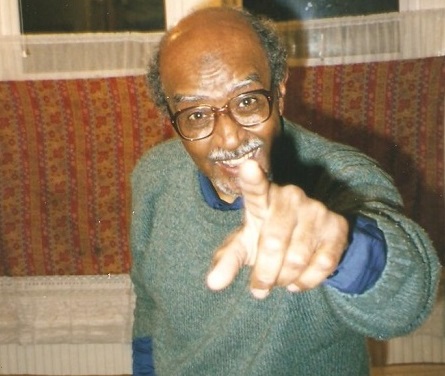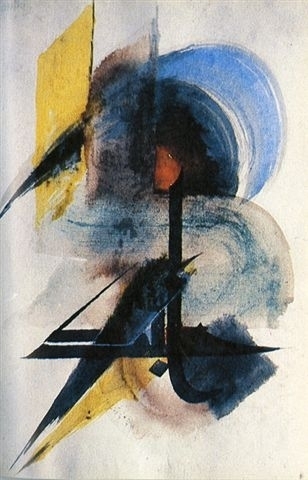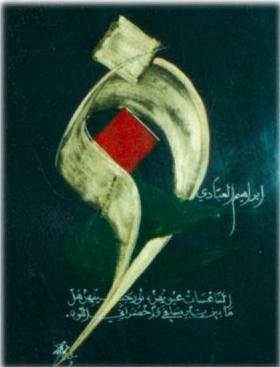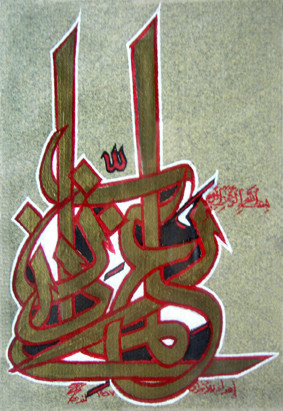
Waqi Allah is one of the most important calligraphers in the Arab world. He loved the Arabic letter, and gave it from his inventory an exceptional artistic energy, and because he possesses in his depths a great energy of creativity, so he set out with the Arabic letter outside the ordinary, to give him more possibilities and dreamy poetic suggestions, and transmit it On the panels occupied a formative art map. The art of UthmanWaqiallah will remain lofty, because it bears his sincerity, loyalty, and his celebration of Arabic calligraphy . This creative artist had a tremendous ability to give, and a high skill in discharging his creative energy on the Arabic letter and out of the ordinary to make formations that harmonize with the color and coexist with the subject, to embody the aesthetic values with which he was able to dig his name deeply ...

Waqi` Allah is considered the father of generations of talented calligraphers, he is an influential figure for generations of his countrymen, as he is the owner of a creative experience that was a valuable addition and contemporary experiences in composition and calligraphy. The exhibition "The Fourth Dimension" brings my works back into the spotlight, giving way to their contemporary aesthetic readings and their re-discovery.

Perhaps what made Waqi` Allah one of the most important literal artists is his ability to move the Arabic letter out of the families of repetition and decoration, to the freedom to expand in the area of the painting, as an element complete in itself, without neglecting its identity as well. Where he remained busy, as he shows in one of his articles, to come out with the art of Arabic calligraphy from "the shell of the Turkish piece to the broad horizons of artistic freedom represented in removing framing, calligraphy improvisations, and monotonous decoration." This is the experience that resulted in his method of forming calligraphy, which he called "the fourth dimension of Arabic calligraphy.

Othman Waqi` Allah, with his unique handwriting, produced some Qur’ans and a large number of Qur’anic paintings, and he is a founding professor of the Faculty of Fine Arts in 1951, and the first free studio for a Sudanese artist, and he contributed to the establishment of the European program in the Sudanese Radio, .
The late artist Professor Othman Waqi Allah (1925 - 2007) is considered the pioneer of the Khartoum School, which was inspired by the formulas and aesthetics of Arabic calligraphy. He received the Order of Achievement from the Presidency of the Republic in Sudan, and a license from the Egyptian calligrapher, Syed Ibrahim.

The late lived in Britain between 1967 and 2005, and during this period he worked for the British Broadcasting Corporation, lectured in British universities, was a member of the International Journalists Union and the British Journalists Syndicate, as well as an expert on lines before British courts, and organized Numerous exhibitions, including those held at the County Institute of Art, Oxford University Institute, and others. And history preserves Othman that he was the first Sudanese to achieve excellence in calligrap

|
|
century Sudanese painter and calligrapher, noted for his creative use of Arabic letter forms in his artworks, thereby integrating African and Islamic cultural traditions into the contemporary art of Sudan.[1] This use of Arabic calligraphy as a modern, non-religious graphic form places Waquialla within the Arabic art movement that became known as the Hurufiyya movement.

Waqialla was born in Rufa'a, in Central Sudan, Al Jazirah state on the banks of the Blue Nile. He graduated from the School of Design, Gordon Memorial College, Khartoum, Sudan in 1945. In 1946, he received a scholarship and moved to England to join Camberwell School of Arts and Crafts in London and finished his studied in 1949. Later he moved to Cairo, Egypt, where he trained as a calligrapher under the master Sayyid Muhammed Ibrahim (died 1994) at the Cairo School of Arabic Calligraphy.[1]
During his time at Camberwell School of Art and Crafts, London, and the School of Arabic Calligraphy, Cairo, Waqialla explored the expressive and compositional possibilities of Arab calligraphic form in his paintings. He thus became one of the first artists to free Arab calligraphy from its historical relationship with the sacred Islamic texts and to propose it as a veritable resource for modernist art. At the time, this was a revolutionary idea.
After completing his studies, he moved back to Sudan at the beginning of the 1950s, where he taught at the College of Fine and Applied Art of the Sudan University of Science and Technology. In the early 1960s, some of Waqialla’s students at this college, such as Ahmed Mohammed Shibrain (b. 1931),[3] Ibrahim el-Salahi (b. 1930) and Tag el-Sir Ahmed (b. 1933)[4] joined in the task of creating a new Sudanese modernist art movement.[5][6] From 1954 to 1964, he also worked in his Studio Osman for graphic design, that was known as a meeting place for artists and intellectuals in Khartoum. Apart from his paintings, he wrote poetry and articles about culture. In 1956, he designed the first banknotes of the newly independent state. In 1967, he moved back to London and worked as a consultant calligrapher for the firm of banknote makers De La Rue. - Two years after his final return to Sudan, he died on 4 January 2007, aged 81to in soudan
- His work can be found in collections of the National.Museum of African Art. In Washington. D.C. and in the British Museum in London. And in many pvivate collections “ The bulk of his work remains in Sudan
List of selected artworks
- Kaf ha ya ayn sadd, 1980 British Museum
- Kufic calligraphy, 1991
- Calligraphy Coming to Life, date unknown
- Portrait of a Man, date unknown
Selected exhibitions
- 1952: Osman Waiquialla, Cultural Centre, Khartoum (solo exhibition)
- 1969: Osman Waiquialla, Camden Art Centre, England (solo exhibition)
- 1995: Seven Stories Exhibition, Whitechapel Art Gallery, London (exhibition of modern African art)
- 1995: Signs, Traces and Calligraphy Show, Barbican Art Centre, The Curve Gallery, London
- 1996: Seven Stories Exhibition, Guggenheim Museum, New York
- 1999: Writing Arabic, British Museum's touring exhibition
- 2006: Word into Art, British Museum
".

